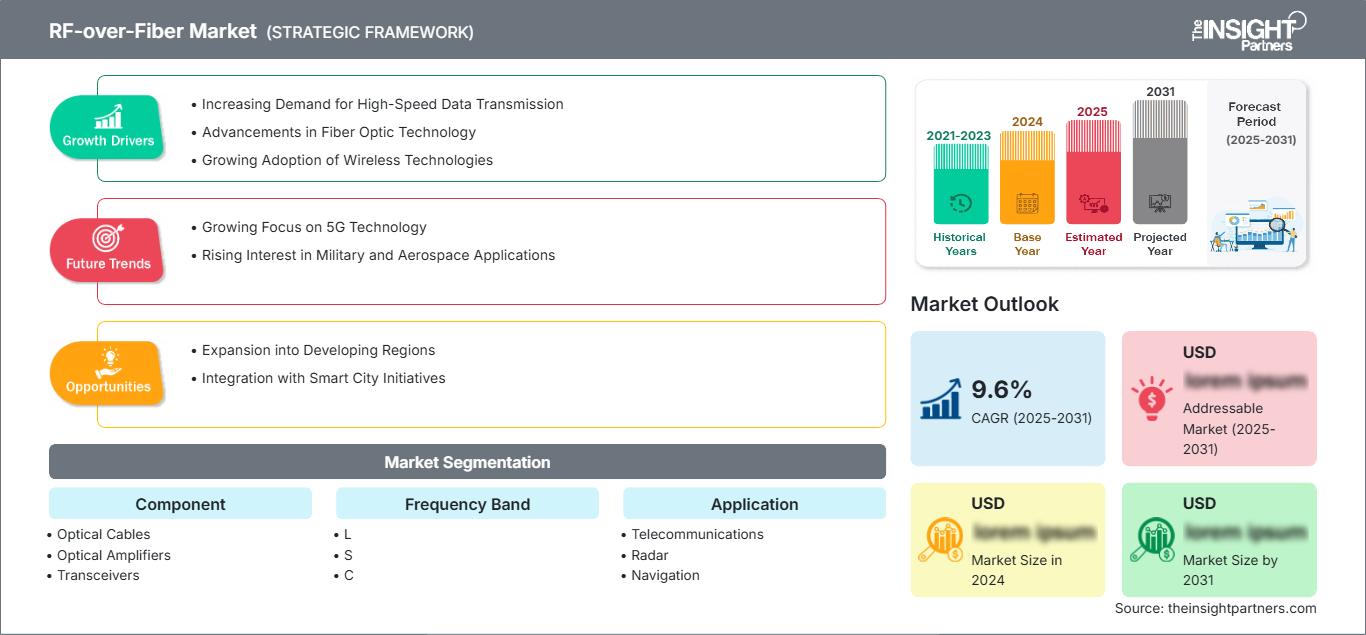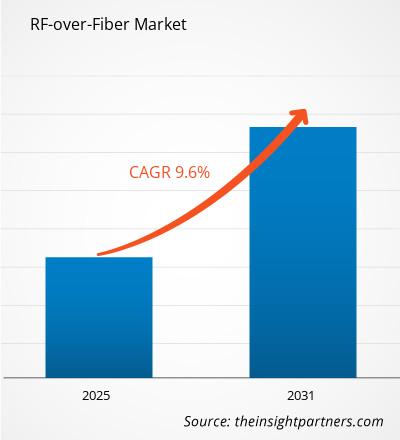Le marché de la RF sur fibre devrait enregistrer un TCAC de 9,6 % entre 2025 et 2031, avec une taille de marché passant de XX millions de dollars américains en 2024 à XX millions de dollars américains d'ici 2031.
Le rapport est segmenté par composant (câbles optiques, amplificateurs optiques, émetteurs-récepteurs, commutateurs optiques, antennes et autres), bande de fréquences (L, S, C, X, KU et KA), application (télécommunications, radar, navigation, diffusion et haut débit), utilisation finale (civile et militaire). L'analyse mondiale est ensuite ventilée au niveau régional et par principaux pays. Le rapport offre la valeur en USD pour l'analyse et les segments ci-dessus.
Objectif du rapport
Le rapport sur le marché de la RF sur fibre de The Insight Partners vise à décrire le paysage actuel et la croissance future, les principaux facteurs moteurs, les défis et les opportunités. Cela fournira des informations à diverses parties prenantes commerciales, telles que :
- Fournisseurs/fabricants de technologie : pour comprendre l’évolution de la dynamique du marché et connaître les opportunités de croissance potentielles, leur permettant de prendre des décisions stratégiques éclairées.
- Investisseurs : pour effectuer une analyse complète des tendances concernant le taux de croissance du marché, les projections financières du marché et les opportunités qui existent tout au long de la chaîne de valeur.
- Organismes de réglementation : pour réglementer les politiques et surveiller les activités du marché dans le but de minimiser les abus, de préserver la confiance des investisseurs et de maintenir l’intégrité et la stabilité du marché.
Composant de segmentation du marché RF sur fibre
- Câbles optiques
- Amplificateurs optiques
- Émetteurs-récepteurs
- Commutateurs optiques
- Antennes
- Autres
Bande de fréquences
- L
- S
- C
- X
- KU
- KA
Application
- Télécommunications
- Radar
- Navigation
- Diffusion
- Haut débit
Utilisation finale
- Civil et militaire
Vous bénéficierez d’une personnalisation sur n’importe quel rapport - gratuitement - y compris des parties de ce rapport, ou une analyse au niveau du pays, un pack de données Excel, ainsi que de profiter d’offres exceptionnelles et de réductions pour les start-ups et les universités
Marché de la RF sur fibre: Perspectives stratégiques

-
Obtenez les principales tendances clés du marché de ce rapport.Cet échantillon GRATUIT comprendra une analyse de données, allant des tendances du marché aux estimations et prévisions.
Moteurs de croissance du marché de la RF sur fibre
- Demande croissante de transmission de données à haut débit : Le marché de la RF sur fibre est stimulé par le besoin croissant de transmission de données à haut débit dans divers secteurs. Face à la demande croissante d'applications gourmandes en bande passante, telles que les réseaux 5G, l'Internet des objets (IoT) et le streaming vidéo haute définition, la technologie RF sur fibre offre une solution fiable. Cette technologie permet la transmission transparente de signaux radiofréquence sur des câbles à fibre optique, améliorant considérablement les vitesses et la capacité de transfert de données, ce qui la rend essentielle aux infrastructures de communication modernes.
- Progrès de la technologie de la fibre optique : Les progrès continus de la technologie de la fibre optique propulsent également le marché de la RF sur fibre. Des innovations telles que l'amélioration des matériaux de fibre, des techniques de traitement du signal et des architectures réseau optimisées rendent les solutions RF sur fibre plus efficaces et plus rentables. Ces améliorations technologiques permettent des distances de transmission plus longues, des débits de données plus élevés et une fiabilité accrue, faisant des systèmes RF sur fibre une option attrayante pour diverses applications, notamment les télécommunications, l'aérospatiale et les communications militaires.
- Adoption croissante des technologies sans fil : L'adoption croissante des technologies sans fil est un autre moteur important du marché de la RF sur fibre. La transition des industries vers les systèmes de communication sans fil s'accompagne d'un besoin correspondant de solutions de distribution de signaux efficaces. La technologie RF sur fibre permet l'intégration de systèmes sans fil aux réseaux de fibre optique, permettant une connectivité transparente et une meilleure qualité du signal. Cette tendance est particulièrement répandue dans des secteurs tels que les télécommunications et la radiodiffusion, où une distribution de signaux fiable et de haute qualité est cruciale.
Tendances futures du marché de la RF sur fibre
- Focus croissant sur la technologie 5G : Une tendance importante sur le marché de la RF sur fibre est l'intérêt croissant pour la technologie 5G. Alors que les entreprises de télécommunications investissent massivement dans l'infrastructure 5G, les solutions RF sur fibre optique deviennent essentielles pour permettre la transmission de données à haut débit et les communications à faible latence. La capacité de la technologie RF sur fibre optique à prendre en charge les besoins importants en bande passante des réseaux 5G la positionne comme un élément clé de la prochaine génération de communications sans fil, favorisant ainsi son adoption sur le marché.
- Intérêt croissant pour les applications militaires et aérospatiales : La technologie RF sur fibre optique suscite un intérêt croissant pour les applications militaires et aérospatiales. Le besoin de systèmes de communication sécurisés et fiables dans ces secteurs stimule la demande de solutions RF sur fibre optique capables d'assurer une transmission de signaux haute performance sur de longues distances. Alors que les organisations de défense et d'aérospatiale cherchent à améliorer leurs capacités de communication, l'adoption de la technologie RF sur fibre devrait augmenter, reflétant une tendance significative du marché.
Opportunités du marché RF sur fibre
- Expansion dans les régions en développement : Le marché RF sur fibre offre d'importantes opportunités de croissance dans les marchés émergents. Les pays de régions comme l'Asie-Pacifique, l'Amérique latine et l'Afrique connaissent un développement rapide des infrastructures et des investissements croissants dans les télécommunications. À mesure que ces marchés étendent leurs réseaux de communication, la demande de solutions RF sur fibre innovantes pour prendre en charge la transmission de données à haut débit augmente. Les entreprises qui pénètrent stratégiquement ces marchés peuvent capitaliser sur le besoin croissant de technologies de communication avancées.
- Intégration aux initiatives des villes intelligentes : L'essor des initiatives des villes intelligentes offre des opportunités lucratives pour le marché RF sur fibre. Alors que les zones urbaines cherchent à améliorer la connectivité et l'efficacité grâce aux technologies intelligentes, les solutions RF sur fibre peuvent jouer un rôle essentiel dans la prise en charge de diverses applications, telles que l'éclairage intelligent, la gestion du trafic et les systèmes de sécurité publique. En fournissant une infrastructure de communication robuste et à haut débit, la technologie RF sur fibre peut faciliter la mise en œuvre de projets de villes intelligentes, créant ainsi d'importantes perspectives commerciales pour les fournisseurs de technologies.
Aperçu régional du marché RF sur fibre
Les tendances régionales et les facteurs influençant le marché de la RF sur fibre optique tout au long de la période de prévision ont été détaillés par les analystes de The Insight Partners. Cette section aborde également les segments et la géographie du marché de la RF sur fibre optique en Amérique du Nord, en Europe, en Asie-Pacifique, au Moyen-Orient et en Afrique, ainsi qu'en Amérique du Sud et en Amérique centrale.
Portée du rapport sur le marché de la RF sur fibre
By Bande de fréquence- L
- S
- C
- X
- KU
- KA
- télécommunications
- radar
- navigation
- diffusion
- haut débit
- civile et militaire
- Royaume-Uni
- Allemagne
- France
- Russie
- Italie
- reste de l'Europe
- Chine
- Inde
- Japon
- Australie
- reste de l'Asie-Pacifique
- Brésil
- Argentine
- reste de l'Amérique du Sud et centrale
- Afrique du Sud
- Arabie saoudite
- Émirats arabes unis
- reste du Moyen-Orient et de l'Afrique
Attribut de rapport Détails Taille du marché en 2024 US$ XX million Taille du marché par 2031 US$ XX Million TCAC mondial (2025 - 2031) 9.6% Données historiques 2021-2023 Période de prévision 2025-2031 Segments couverts By Composants - câbles optiques
- amplificateurs optiques
- émetteurs-récepteurs
- commutateurs optiques
- antennes
- autres
Régions et pays couverts Amérique du Nord - États-Unis
- Canada
- Mexique
Leaders du marché et profils d'entreprises clés - APIC Corporation
- EMCORE Corporation
- ETL Systems Ltd
- Finisar Corporation
- Foxcom
- Glenair
- HUBER+SUHNER
- Optical Zonu Corp
- SEIKOH GIKEN Co., Ltd.
Densité des acteurs du marché RF sur fibre : comprendre son impact sur la dynamique des entreprises
Le marché de la RF sur fibre optique connaît une croissance rapide, portée par une demande croissante des utilisateurs finaux, due à des facteurs tels que l'évolution des préférences des consommateurs, les avancées technologiques et une meilleure connaissance des avantages du produit. Face à cette demande croissante, les entreprises élargissent leur offre, innovent pour répondre aux besoins des consommateurs et capitalisent sur les nouvelles tendances, ce qui alimente la croissance du marché.

- Obtenez le Marché de la RF sur fibre Aperçu des principaux acteurs clés
- Analyse historique (2 ans), année de base, prévision (7 ans) avec TCAC
- Analyse PEST et SWOT
- Taille du marché Valeur / Volume - Mondial, Régional, Pays
- Industrie et paysage concurrentiel
- Ensemble de données Excel
Rapports récents
Rapports connexes
Témoignages
Raison d'acheter
- Prise de décision éclairée
- Compréhension de la dynamique du marché
- Analyse concurrentielle
- Connaissances clients
- Prévisions de marché
- Atténuation des risques
- Planification stratégique
- Justification des investissements
- Identification des marchés émergents
- Amélioration des stratégies marketing
- Amélioration de l'efficacité opérationnelle
- Alignement sur les tendances réglementaires






















 Obtenez un échantillon gratuit pour - Marché de la RF sur fibre
Obtenez un échantillon gratuit pour - Marché de la RF sur fibre